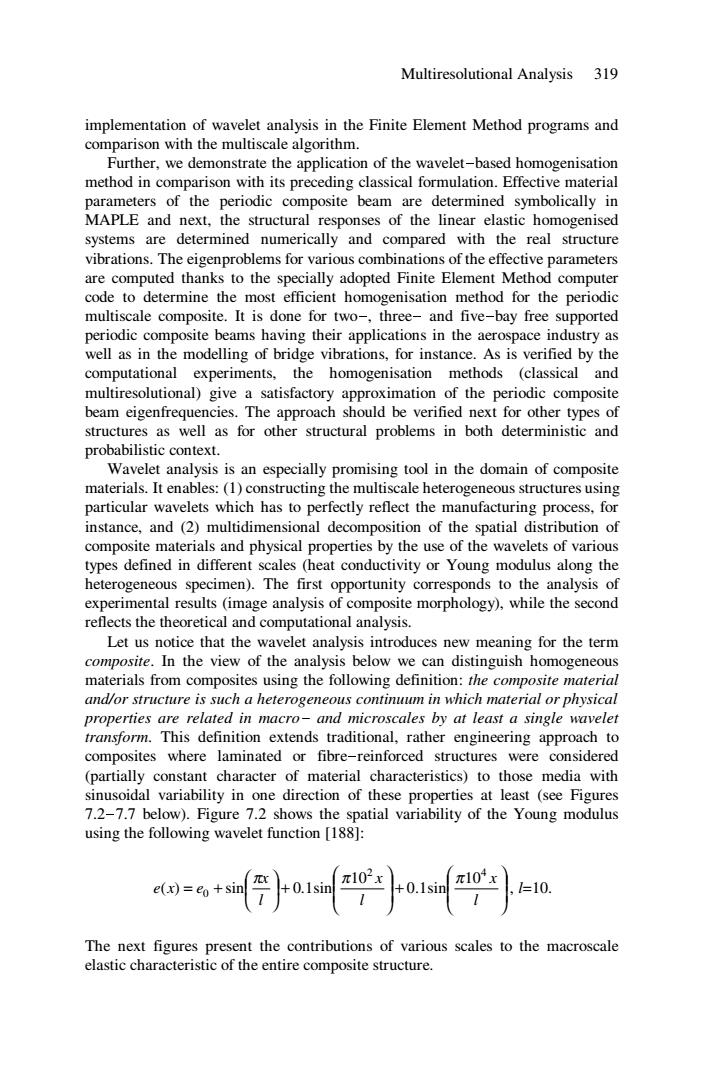正在加载图片...

Multiresolutional Analysis 319 implementation of wavelet analysis in the Finite Element Method programs and comparison with the multiscale algorithm. Further,we demonstrate the application of the wavelet-based homogenisation method in comparison with its preceding classical formulation.Effective material parameters of the periodic composite beam are determined symbolically in MAPLE and next,the structural responses of the linear elastic homogenised systems are determined numerically and compared with the real structure vibrations.The eigenproblems for various combinations of the effective parameters are computed thanks to the specially adopted Finite Element Method computer code to determine the most efficient homogenisation method for the periodic multiscale composite.It is done for two-,three-and five-bay free supported periodic composite beams having their applications in the aerospace industry as well as in the modelling of bridge vibrations,for instance.As is verified by the computational experiments,the homogenisation methods (classical and multiresolutional)give a satisfactory approximation of the periodic composite beam eigenfrequencies.The approach should be verified next for other types of structures as well as for other structural problems in both deterministic and probabilistic context. Wavelet analysis is an especially promising tool in the domain of composite materials.It enables:(1)constructing the multiscale heterogeneous structures using particular wavelets which has to perfectly reflect the manufacturing process,for instance,and (2)multidimensional decomposition of the spatial distribution of composite materials and physical properties by the use of the wavelets of various types defined in different scales (heat conductivity or Young modulus along the heterogeneous specimen).The first opportunity corresponds to the analysis of experimental results (image analysis of composite morphology),while the second reflects the theoretical and computational analysis. Let us notice that the wavelet analysis introduces new meaning for the term composite.In the view of the analysis below we can distinguish homogeneous materials from composites using the following definition:the composite material and/or structure is such a heterogeneous continuum in which material or physical properties are related in macro-and microscales by at least a single wavelet transform.This definition extends traditional,rather engineering approach to composites where laminated or fibre-reinforced structures were considered (partially constant character of material characteristics)to those media with sinusoidal variability in one direction of these properties at least (see Figures 7.2-7.7 below).Figure 7.2 shows the spatial variability of the Young modulus using the following wavelet function [188]: The next figures present the contributions of various scales to the macroscale elastic characteristic of the entire composite structure.Multiresolutional Analysis 319 implementation of wavelet analysis in the Finite Element Method programs and comparison with the multiscale algorithm. Further, we demonstrate the application of the wavelet-based homogenisation method in comparison with its preceding classical formulation. Effective material parameters of the periodic composite beam are determined symbolically in MAPLE and next, the structural responses of the linear elastic homogenised systems are determined numerically and compared with the real structure vibrations. The eigenproblems for various combinations of the effective parameters are computed thanks to the specially adopted Finite Element Method computer code to determine the most efficient homogenisation method for the periodic multiscale composite. It is done for two-, three- and five-bay free supported periodic composite beams having their applications in the aerospace industry as well as in the modelling of bridge vibrations, for instance. As is verified by the computational experiments, the homogenisation methods (classical and multiresolutional) give a satisfactory approximation of the periodic composite beam eigenfrequencies. The approach should be verified next for other types of structures as well as for other structural problems in both deterministic and probabilistic context. Wavelet analysis is an especially promising tool in the domain of composite materials. It enables: (1) constructing the multiscale heterogeneous structures using particular wavelets which has to perfectly reflect the manufacturing process, for instance, and (2) multidimensional decomposition of the spatial distribution of composite materials and physical properties by the use of the wavelets of various types defined in different scales (heat conductivity or Young modulus along the heterogeneous specimen). The first opportunity corresponds to the analysis of experimental results (image analysis of composite morphology), while the second reflects the theoretical and computational analysis. Let us notice that the wavelet analysis introduces new meaning for the term composite. In the view of the analysis below we can distinguish homogeneous materials from composites using the following definition: the composite material and/or structure is such a heterogeneous continuum in which material or physical properties are related in macro- and microscales by at least a single wavelet transform. This definition extends traditional, rather engineering approach to composites where laminated or fibre-reinforced structures were considered (partially constant character of material characteristics) to those media with sinusoidal variability in one direction of these properties at least (see Figures 7.2-7.7 below). Figure 7.2 shows the spatial variability of the Young modulus using the following wavelet function [188]: ⎟ ⎟ ⎠ ⎞ ⎜ ⎜ ⎝ ⎛ +⎟ ⎟ ⎠ ⎞ ⎜ ⎜ ⎝ ⎛ ⎟ + ⎠ ⎞ ⎜ ⎝ ⎛ = + l x l x l x e x e 2 4 0 10 0.1sin 10 ( ) sin 0.1sin π π π , l=10. The next figures present the contributions of various scales to the macroscale elastic characteristic of the entire composite structure